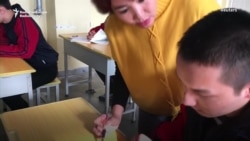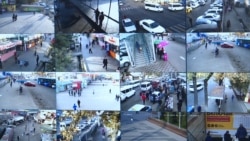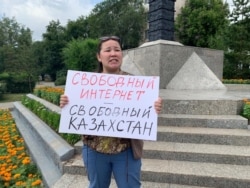2019 was a momentous year of events and change in Central Asia. Here's a look at four of the most important issues reverberating in the region: the five countries and their relations with China, the perennial threat of Islamic terrorism emanating from Afghanistan, how governments can impede the flow of information by controlling the Internet, and the invasion of facial recognition technology into the region.
China-Central Asian Relations Reversing Course?
A crowd of supporters gathered outside a district courthouse in Kazakhstan’s southeastern Almaty Province on December 25 to happily greet five men who had just been freed from custody after being sentenced to probation.
The Kazakhs were accused of hooliganism for their part in a fight with Chinese road-construction workers in early October that left several Chinese workers injured.
Chinese General Liu Yazhou was widely quoted as saying that 'Central Asia is the thickest piece of cake given to modern China by the heavens.'"
The five Kazakhs faced up to three years in prison, and just a few years ago they might have been handed such sentences. But not this time.
As 2019 showed, Central Asian views toward China seem to be "a-changin'."
For most of the past 20 years, many people in Central Asia have equated China with jobs and money. China signed its first big contract with Kazakhstan in 1997 to build a pipeline to bring oil from western Kazakhstan to China. Many contracts followed -- not just between China and Kazakhstan, but also with the other four Central Asian countries.
When the global economic crisis hit in 2008, China -- the neighboring giant -- was still flush with cash and anxious to invest, particularly in the region's abundant energy resources that could continue to fuel China’s unbridled economic expansion.
James Nixey of Chatham House told RFE/RL in 2010 that China viewed Central Asia as “a quarry [from which] to extract hydrocarbons."
In January 2011, Chinese General Liu Yazhou echoed that comment when he was widely quoted saying that "Central Asia is the thickest piece of cake given to modern China by the heavens."
Getting this thick slice of cake back to China has required substantial Chinese investment in Central Asia, much of it loans that some of those governments will be hard-pressed to repay.
Additionally, there is the matter of Chinese workers in Central Asia.
Central Asia’s people have a long historical experience with the Chinese, but for most of the 20th century -- when Central Asia was part of the Soviet Union -- there was no contact due to the sealed border. So the thousands of Chinese workers employed throughout Central Asia must seem like an invasion to many.
And combined with earlier memories in Kazakhstan, Kyrgyzstan, and Tajikistan -- where China renegotiated the post-Soviet borders and all three Central Asian states ceded land to China -- the presence of so many Chinese in Central Asia fuels speculation that Beijing may be looking to further expand China’s borders.
Protests in Kazakhstan in April and May 2016 over planned land privatization were sparked by rumors that the Chinese would buy up Kazakh land.
The fight among road-construction workers in Kazakhstan in October was not the biggest clash between locals and Chinese workers in Central Asia during 2019.
In early August, a group of several hundred residents of Kyrgyzstan’s northern Naryn Province attacked Chinese workers from the Zhong Ji Mining Company. At least 47 Chinese workers were injured.
And Central Asian debt to China is a problem people are increasingly aware of, particularly in Kyrgyzstan and Tajikistan.
Nearly half of Kyrgyzstan’s external debt and more than 35 percent of Tajikistan’s is owed to China.
In Kyrgyzstan’s case, the issue has received added attention due to the fiasco over the repair and upgrade of the thermal power plant that powers the capital, Bishkek.
China provided some $386 million for the work, but in January 2018 the plant broke down just months after operations resumed. A subsequent investigation determined nearly $100 million of the invested money had been siphoned off. And Kyrgyzstan may have to eventually pay China some $493 million to cover their debt.
In Tajikistan’s case, the $331 million China’s Eximbank loaned to build a thermal power plant in Dushanbe is being paid off, according to a November report, by granting Chinese companies mining rights to two gold deposits that some estimate contain 64 tons of gold.
Anti-Chinese sentiment is further stoked in Central Asia by Beijing’s policies toward Muslims in China’s western Xinjiang Uyghur Autonomous Region (XUAR) -- but has been especially noticeable in Kazakhstan and Kyrgyzstan.
The reported internment of some 1 million Muslims in XUAR puts the Kazakh and Kyrgyz governments in a difficult position.
When the Chinese began detaining and incarcerating ethnic Uyghurs, a Turkic Muslim group related to Kazakhs and Kyrgyz, the Kazakh and Kyrgyz governments avoided commenting.
WATCH: Chinese 'Deradicalization' Camps: Education Or Persecution? (originally published January 2019)
But when ethnic Kazakhs and Kyrgyz who had moved from Xinjiang to Kazakhstan and Kyrgyzstan and become citizens were detained and put in the so-called “reeducation camps” during visits to Xinjiang, stories of the horrific actions by the Chinese spread.
Despite the growing resentment against China in Kyrgyzstan, President Sooronbai Jeenbekov warned several times during 2019 that he would not allow anyone in the country to spoil relations with China over the issue.
In Kazakhstan, when President Nursultan Nazarbaev stepped down from office in March 2019 after more than 27 years as the country’s only president, opposition arose swiftly against his handpicked successor, Qasym-Zhomart Toqaev.
Youth groups and more established opposition organizations criticized the transfer of power and, in the months that followed, their list of complaints included scaling back ties with China and ceasing to kowtow to Beijing over the Xinjiang issue.
The number of ethnic Kazakhs fleeing from Xinjiang to Kazakhstan is still low but increasing, with many telling of the horrors they or relatives have experienced at the reeducation camps. Beijing has demanded such people be extradited, and it is a dilemma that Central Asia countries -- particularly Kazakhstan -- are struggling with.
Kazakhstan’s government most keenly feels the growing hostility of its population toward China, but it is spreading through Central Asia as many see their government officials getting rich off of Chinese money while the people prepare to pay off billions of dollars that will be owed for decades to a country that is trying to extinguish the culture of its Muslims.
The Perennial Threat Of Terrorism In Central Asia
The threat of terrorism has hung over Central Asia since the days of independence in the early 1990s. Central Asia’s border with Afghanistan spans more than 2,000 kilometers and, as long as Afghanistan is at war, there will be concern inside Central Asia -- and warnings from outside the region -- about the threat of terrorism.
There were no terrorist attacks in Central Asia in 2019, unless one accepts the Tajik government’s widely discredited account of a November 6, 2019, attack on its southwestern Ishkobod border post near Afghanistan.
Tajik officials say militants from the extremist Islamic State (IS) terrorist group crossed from Afghanistan’s Kunduz Province into Tajikistan specifically to carry out acts of terror. IS later claimed responsibility for the attack that left at least one Tajik policeman and border guard dead (though later reports claimed at least five more border guards were killed) as well as 15 of the 20 attackers.
Information that subsequently emerged, such as the fact that women and children had participated in the attack, cast much doubt on an IS link.
But for the many parties who see militants behind practically every rock on the Afghan side of the border, the Tajik government’s version of events just proved what they have been warning about. And in the case of Russia and China, this meant offering or forcing their help on Central Asia wherever possible.
China captured the security news in Central Asia in February 2019 when it was revealed that Beijing had established a military facility in the remote, high mountains of far eastern Tajikistan, not far from the Chinese and Afghan borders. Since the start of this decade there have been reports about Chinese personnel from anti-narcotics and other state agencies cooperating with Tajik border guards -- sometimes including raids into Afghan territory -- but The Washington Post report was the first confirmation that China had a base in Tajikistan, which the report said had been operational for three or four years.
Neither the Chinese nor Tajik governments have confirmed the presence of the base. But the report of it being in Tajikistan came after sightings of troops from China’s People's Armed Police in Afghanistan’s Wakhan Corridor, just south of the base in Tajikistan.
China is worried that Uyghurs who fled to Middle Eastern conflict zones to join extremist groups might attempt to return to XUAR via the remote mountain passes where Afghanistan, Tajikistan, and China meet.
This concern led China to form a new security group with Afghanistan, Pakistan, and Tajikistan in 2016, and Beijing has been eager to help all Central Asian states with counterterrorism measures, seeing the region as the bulwark against terrorism reaching its borders.
Russia sees Central Asia in similar terms.
The Russian government and military officials continued to remind the Central Asian states throughout 2019 of the dangers they face from militants in Afghanistan.
Russian Ambassador to Afghanistan Aleksandr Mantysky said in February 2019, “[IS] is trying to increase the number of its militants operating in the country's north, including on the borders with Turkmenistan and Tajikistan, in order to use the north as a foothold for crossing into Central Asian states.” He added that there were anywhere from 3,500 to 10,000 IS fighters in Afghanistan. In December 2019, Russian Security Council Secretary Nikolai Patrushev said IS was preparing to use northern Afghanistan as a staging area for operations in Tajikistan and Turkmenistan.
There were at least a dozen similar warnings from Russian officials between Mantysky and Petrushev’s comments during 2019, as well as many promises of support for further strengthening Tajikistan’s border with Afghanistan from Russian officials, especially those in the Russian-led Collective Security Treaty Organization (CSTO). In addition to the fact that Russia’s 201st Division remains deployed in Tajikistan.
Kyrgyzstan, also a CSTO member that hosts a Russian military base, received similar Russian warnings and pledges of support during 2019.
With the United States and other foreign forces in Afghanistan currently seeking a way to end their military presence there, the Central Asian states are likely to continue to gravitate closer to Russia and China to ensure their own security against the real -- or imagined -- threat of Islamic terrorism coming from Afghanistan.
Smile, You’re On Candid Camera!
In October 2019, residents of Kazakhstan’s capital, Nur-Sultan, were given an opportunity to pay for their rides on public buses using a new technology that unnerved many people.
Passengers boarding buses in Nur-Sultan were given the opportunity to register with a company called FacePay and use the company’s facial-recognition system to pay their fare rather than using cash or public transport cards.
FacePay advertised the advantages of registering with its system -- no need for cash and an easy way to pay -- but some saw it as a first step by the government to monitor the movement and activities of its citizens.
Facial-recognition cameras are causing controversy around the globe, all the more so since China developed such systems to monitor the activities of its people, particularly in Xinjiang.
The system in use in Nur-Sultan is the product of the Chinese company HikVision, which the U.S. government has blacklisted for its role in the repression of Muslims in Xinjiang.
Kazakhstan is developing its own facial-recognition technology.
The Sergek video-surveillance system has been in operation in Nur-Sultan since 2018 with the stated purpose of monitoring road traffic.
But Sergek reportedly uses equipment that came from Dahua Technology, another Chinese company the U.S. government has blacklisted.
But facial recognition and video-monitoring systems are not only a concern in Kazakhstan.
An article in Foreign Policy in November noted that "Kyrgyzstan opened a new police command center in its capital, Bishkek, putting its new facial-recognition cameras to work." The report said the technology "was supplied free of charge by the China National Electronics Import and Export Corporation, a company currently sanctioned by the United States."
Reports note that projects for so-called "smart cities" in Tajikistan and Uzbekistan also have facial recognition and video surveillance as a central feature.
Although Turkmenistan is not mentioned in the reports, it would be fair to guess the government in Ashgabat -- which has long been obsessed with internal security -- has reached out to China for this technology, as it has for weapons and military equipment.
A September article in PONARS Eurasia summed up the dilemma, noting that "the systems are part of the 'smart city' and 'safe city' concepts that have been gaining popularity around the world as a response to rapid urbanization," relying on "digital technologies to improve urban life, but the tools also offer a structure to potentially expand authoritarian control over people and public places."
The Internet: How Much Is Enough?
Control of the Internet remained a major topic for governments in Central Asia in 2019.
There was the Turkmen way of dealing with potentially damaging articles or information, which remains to simply block almost everything. Tajikistan is not far behind Turkmenistan in this regard.
But in 2019, it was the policies of Kazakhstan and Uzbekistan that took the spotlight, for very different reasons.
As mentioned earlier, the formal change of presidents in Kazakhstan inspired some people to demonstrate for change.
The change provided the Democratic Choice of Kazakhstan (DVK) leader, fugitive former banker Mukhtar Ablyazov, to again take to social networks to call for protests against the government. The DVK was not the only group trying to use social networks to organize demonstrations.
Faced with this challenge to the succession plan, Kazakh authorities fought back, often detaining leaders of planned rallies ahead of time, blocking some websites, and severely slowing the Internet before and during demonstrations.
Rallies were planned on the May 9 holiday marking the end of World War II, but on that day the websites of RFE/RL’s Kazakh Service and local websites Vlast.kz, Holanews.kz, Informburo.kz, Exclusive.kz, Time.kz, and others were blocked.
The Internet freedom website NetBlocks.org reported Facebook, Instagram, YouTube, Telegram, and several independent and petition sites were also blocked across Kazakhstan that day.
Kazakh Information Minister Dauren Abaev denied his ministry had anything to do with the Internet problem.
But NetBlocks.org reported "blocked access to online streaming services as well as totally cutting the Internet access for most users" on June 9, the day of the Kazakh presidential election, and said the blocks occurred during "reported detentions of journalists and political activists at demonstrations in Nur-Sultan, Almaty, and Shymkent."
The situation was repeated several times after that, always during planned demonstrations. It was therefore hardly surprising that a renewed offer in July from state-controlled Qaznet Trust Network to register for a program that promised cybersecurity for users was met with skepticism.
Since Shavkat Mirziyoev took over as Uzbek president in late 2016, the government has been promoting the changes in the country that are, according to Uzbek authorities, making Uzbekistan an attractive place for investment and tourism.
In May, shortly after Kazakhstan blocked websites on the May 9 holiday, Uzbekistan announced it was unblocking access to dozens of what Reporters Without Borders called "long-censored news websites."
As 2019 drew to a close, many previously blocked websites were still accessible in Uzbekistan, though RFE/RL’s website remained blocked.












